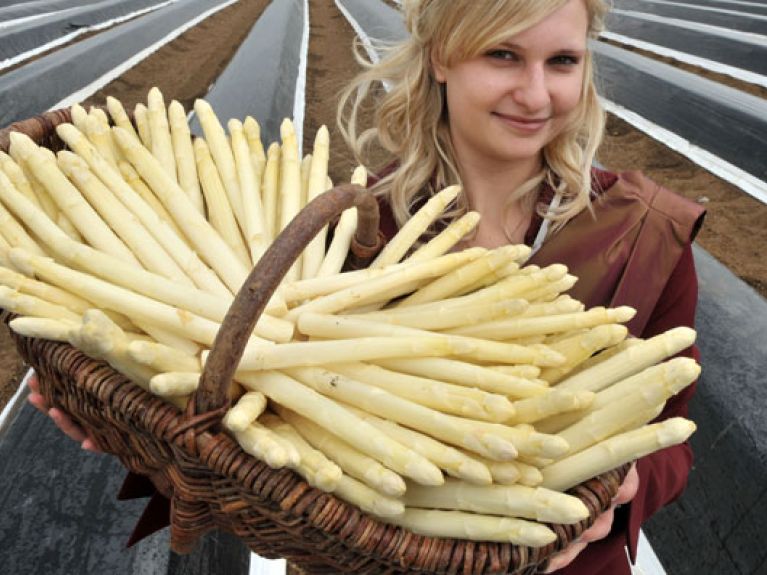Asparagus mania
No sooner is spring in the air than the Germans succumb to their favourite vegetable – asparagus. A culinary investigation.

The world over, the inhabitants of many countries are associated with a particular vegetable which is considered typical of that country. In Italy it is the tomato, in France the artichoke, in England peas. If you ask about a typically German vegetable, you are sure to hear mention of cabbage or potatoes – two sorts of vegetable that promise mainly two things: to be filling, and easy to cook. This is quite a stubborn prejudice. Yet it is refuted on a daily basis: the range of vegetables available at any German market is very wide. Depending on the season of the year, local market gardens provide a great variety of products.
Anyone observing German shoppers at the market in springtime will notice a certain nervousness that intensifies with each passing day: their eyes carefully scan the stalls, but they seek in vain. What they are actually looking for are marble-white sticks – asparagus officinalis, or simply asparagus. The approximately 30-centimetre-long sticks grow in the earth, once it warms up in spring. Between April and June asparagus is the Germans’ favourite vegetable. Asparagus is proof that winter is finally over. The farmers call it “white gold”. Last year, 113,000 tonnes were harvested from an area that is 450 times as large as the Vatican, or as large as 28,000 football pitches. The asparagus enthusiast will pay up to 10 euros and more for a kilo of good-quality asparagus – which is more than for any other kind of vegetable.
The Romans more than likely brought asparagus across the Alps with them, along with vines. Later, this noble vegetable was mainly cultivated in monasteries or grown as a medicinal plant. The Greek doctor Hippocrates swore by asparagus, as a medicine that purged the body. The Romans adored the green variety; it was part of every festive meal and even gave rise to a dictum: something that had to happen quickly had to be done “faster than it takes to cook asparagus”.
What is served today as white or pale asparagus is more an invention of the modern era. When it was discovered that asparagus maintains its white colour if protected from the sun’s rays by soil, small mounds of earth were formed which covered the plant’s shoots as they developed. Temperatures of 12 degrees are sufficient for them to ripen. If it gets warmer, the sticks shoot up at a rate of about 7,5 millimetres per hour.
Everywhere in Germany where dry sandy soil allows its cultivation, you will see the long rows of mounds in spring, often covered in black plastic so that the sun’s rays can better heat up the soil. It’s as if the artist Christo had packed the fields. Asparagus is actually a member of the lily family, a plant that spreads out a network of roots mainly beneath the earth. The roots are up to six metres long and the shoots push straight upwards to the earth’s surface as asparagus.
In order to be the first on the market with these highly sought-after sticks, inventive farmers have even installed heating in their fields. Warm water is supposed to accelerate their growth. After all, the earlier the vegetable is sold, the more expensive it is. Although asparagus is cultivated in all the German states, certain regions are regarded as major asparagus-growing centres: Schrobenhausen (Bavaria), Schwetzingen (Baden-Württemberg) or Beelitz (Brandenburg) are place names that only need to be mentioned to make many people’s mouths water. Water is a keyword here: 93% of asparagus is water; all the rest is carbohydrates and proteins. And because it has practically no fat, it does not make you put on weight. It owes its particular tart flavour to the amino acid asparagine and to light sulphur compounds.
Is it the shape that accounts for asparagus supposedly having an aphrodisiacal effect? Although there is no scientific evidence for this, it did not stop the world-famous Comedian Harmonists from singing a 1930s song about spring, which is still popular today: “The whole world has lost its head, Veronika, the asparagus is growing” – two lines that are understood by everyone.
The secret of asparagus is its freshness: it must be on your plate no more than a few hours after being harvested. It cannot be stored. Then, on 24 June, St. John’s Day, the asparagus mania comes to an end. As the folk idiom puts it: “Cherries red, asparagus dead.”

